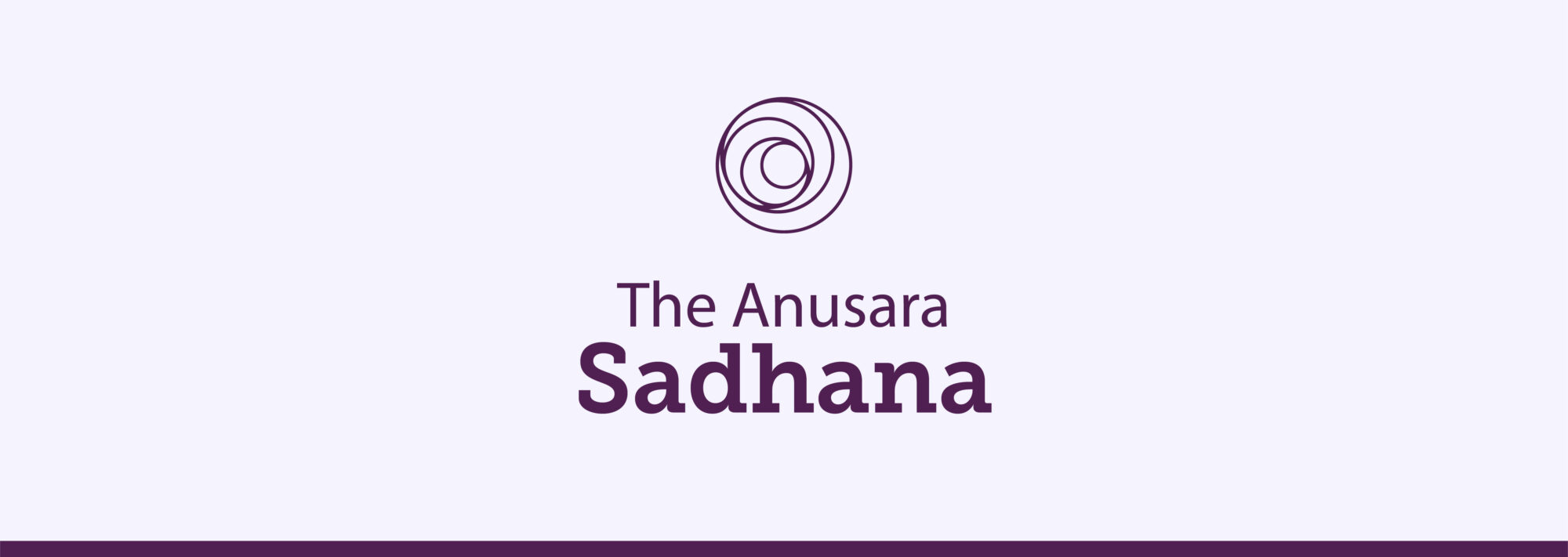The Anusara Sadhana: Prāṇāyāma, Dancing with The Divine
Categories: Becoming an Anusara Teacher, bhakti, community, Methodology, Philosophy, Philosophy, Professional Development


Prāṇāyāma, Dancing with The Divine
Written by Eva Ananya

Inhale … Exhale … We do it about 20,000 times daily, providing every cell in our body with vital nourishment called oxygen. An adult breathes in and out approximately 10 to 15 times per minute. I have verified this for myself; on average, it’s 12 breaths per minute when I’m sitting at my office working. Assuming I take in just over a quarter liter of air per breath, that amounts to about 4 liters of air per minute and around 6,000 liters or 6 m³ per day, and that’s just in a quasi-resting state at my desk. This increases, of course, as soon as I start moving. I find these numbers quite impressive.
Further contemplation makes it clear to me, I breathe far more frequently compared to drinking or eating. I think very carefully about what food and drinks I consume, trying to do so calmly so that my body can properly utilize the nourishment. We all consider what solid and liquid food we feed our bodies. Why not also our gaseous nourishment?
One answer, of course, is that we don’t need to control it. We breathe without needing to actively contribute. But we could.
This was my realization over a decade ago when I began to pay more attention to my nutrition, which also includes oxygen. Through numerous yoga trainings and workshops, I had already learned several Prāṇāyāma techniques, but I knew there was much more than just Kapālabhātī (which actually belongs to the ṣaṭ-karmāṇi, the six cleansing practices, which are explained in the Haṭhapradīpikā – and by the way, it is also mentioned there that we should keep them secret, as they produce extraordinary attributes.”), Ujjāyī, and alternate nostril breathing. So, I began delving deeper into the science of breathing and was fortunate to find an experienced teacher who, through his teacher, had gained deep insights into Prāṇāyāma.
Where do we find references to the control of breath and its importance in yoga literature? The first instructions on how to control the breath are already found in the Vedas, where during rituals the Vedic priests are instructed to influence the breath in a prescribed manner. Later, we find in Patañjali’s Yoga Sūtras in the Aṣṭāṅgamārga, the eight-limbed path, the fourth limb as Prāṇāyāma. The Sūtras in Chapter 2, from 49 to 53 (PYS II.49-53), discuss Prāṇāyāma and its effects. While we estimate these Sūtras to be over 2,000 years old, more and more references and explanations can also be found in ‘newer’ yogic texts. For instance, the Haṭhapradīpikā (circa 14th century AD) treats eight classic Prāṇāyāmas, also in the second chapter:
atha kumbhakabhedāḥ
sūryabhedanam ujjāyī sītkārī śītalī tathā |
bhastrikā bhrāmarī mūrcchā plāvinīty aṣṭa-kumbhakāḥ ||44||
Now the variations of Kumbhaka: Sūryabhedanam, Ujjāyī, Sītkārī, Śītalī likewise,
Bhastrikā, Bhrāmarī, Mūrcchā, Plāvinī – these are the eight breath controls. ||44||
In another important Haṭha Yoga text, the Gheraṇḍasaṃhitā (probably from the late 17th century from Northeast India), explanations on Prāṇāyāma are found in the fifth chapter, and right at the beginning in the first verse, the goal or result of this practice:
athātaḥ saṁpravakṣyāmi prāṇāyāmasya sadvidhim |
Yasya sādhanamātreṇa devatulyo bhavennaraḥ ||1||
Now I shall expound the correct rules of Pranayama.
By its practice alone a man becomes God-like. ||1||
Verse 46 then lists the following eight techniques:
‘sahitaḥ sūryabhedaśca ujjāyī śītalī tathā |
bhastrikā bhrāmarī mūrcchā kevalī cāṣṭa kumbhakāḥ ||46||
And they are very familiar to us, being techniques mostly known from the Haṭhapradīpikā. While Ujjāyī, Bhrāmarī, and also Bhastrikā are known to most yoga practitioners, the other techniques are less so. Therefore, I would like to focus on *sūryabhedana*. In the Haṭhapradīpikā, right after listing the techniques in verse 2.44, in the following verses, we find instructions on how to use the three Bandhas during breathing and also how the yogi can free themselves from aging. And from verse 2.48, the explanation of the sūryabhedana technique begins: A comfortable seat and the yogi should slowly inhale through the right nostril (Piṅgalā nāḍī), practice Kumbhaka, i.e., hold the breath to the utmost, until it is felt from the hair (on the head) to the nail tips (in the toes, i.e., permeating the entire body). Then he should slowly exhale through the left nostril (Ida nāḍī). In verse 2.50, we find the effect described as follows: ‘Cleans the frontal sinuses, combats diseases caused by a disturbance of Vāta and heals diseases caused by worms (bacteria). It should therefore be performed repeatedly.’ In the dialogue between Chanda and Gheraṇḍa in the Gheraṇḍasaṃhitā, the effect is even more elaborated: It destroys decay and death, awakens the Kuṇḍalinī Śakti, and increases the body fire.
The focus for this practice can be intensified by mentally reciting ‘sā’ during inhalation through the right nostril and ‘haṃ’ during exhalation. The ‘Haṃsā’ Mantra is especially used in tantric practice often in this form with the breath to support the concentration for a Dhāraṇā (as in the Vijñāna-Bhairava-Tantra). It is also said to be the natural breath Mantra, which we thus recite daily over 20,000 times. Its literal meaning: ‘That I am’ and if you listen closely, you can actually hear it.
And before we start with the practice – a few words about the breath itself: The four functions of the breath are in-taking of air, the suspension of the in-taken breath, the expiration of body gases during exhalation, and suspension of the breath after exhalation.
The usual terms in Yoga for these four-fold functions are:
- pūraka (in),
- antara kumbhaka (held in),
- recaka (out), and
- śūnyaka or bāhya kumbhaka (held out).
Further sub-divisions of this breathing cycle are a natural suspension of the held-in breath, which we call kevala abhyantara and the natural suspension of the held-out breath, kevala kumbhaka, which also suggests the natural śūnya or sahajā state of the breath (see Haṭhapradīpikā 4.3-4).

Watch Eva’s video and connect to your breath in a deeper level
Sit in Vajrāsana or another stable seated position, such as with crossed legs on the ground (Sukhāsana, Siddhāsana or even Padmāsana). Stretch the crown of your head upwards and lift your sternum so you can sit up with ease. The hand gesture (Hasta Mudrā) that you can use for your right hand is Viṣṇu Mudrā or Nāsāgra Mudrā. For this, bend the middle and index fingers towards the palm, extend the little finger, ring finger, and thumb away. For the left hand, you can choose Cin Mudrā. It symbolizes spiritual unfolding, higher awareness, and activates the secret channel of consciousness (Gupta nāḍī), which leads from the hand on the knee to the cave of the heart (hrid-guhā). It helps distribute the Prāṇa in the body and dissolve energetic blockages (more on this in Indu Arora’s book, The Great Book of Mudrās).
Now bring your right hand with Viṣṇu Mudrā in front of your body. Inhale and hold the breath (apply Jālandhara Bandha if you generally work with these locks), then slowly exhale through the left nostril. Now inhale through the right nostril again and hold the breath again. Continue practicing the cycle. There are several suggestions for the rhythm of this practice, such as inhaling through the right for 4 (pūraka), holding the breath for 16 (antar kumbhaka), and exhaling through the left for 8 (recaka). My recommendation for how you can clearly write down this Tāla (rhythm) is a syntax like this:
In : Pause : Out : Pause
The example here would thus be:
4 : 16 : 8 : 0
For me, this practice always feels like a little sunrise within me, and thus I like to practice it especially in the mornings. As with all techniques, I recommend that you perceive for yourself how it works for you. Of course, you should also give each technique some time following the motto ‘Once is none’.
The breath is a bridge between my inner world and the outer world. With Prāṇāyāma, I can consciously influence my inner world – my physical, emotional and mental perception. Instead of an Espresso in the morning, a Bhastrikā variation helps me much better to wake up, or a calming and relaxing Prāṇāyāma such as sama vritti (box breathing or even breathing) in the evening when I am still very much in my head from a long day at work.
And today we also know that this is not just a perceived effect. There are medical studies that have been able to demonstrate these effects and conclude that directing airflow through the right nostril is of an activating nature, while directing airflow through the left nostril is of a relaxing nature. Heart rate, blood pressure, and reaction time were measured (Bhavanani A., Ramanathan M., Balaji R., Pushpa D. (2014) International Journal of Yoga).
I feel the effects of Prāṇāyāma, and it has changed so much for me on all levels of my being (Kośas). Together with tantric philosophy, it has become my path to yoga along with Āsana practice. And so, it is also my goal to pass on this gift and hope that it is as much a support to you as it is to me.
To start your sadhana, you can try to follow the “3 R’s”:
Regularity, Rhythm and Repetition.
This is the key to the healthy development of your Prāṇāyāma practice. In Yoga, this is the essence of the word Abhyāsa. Choose a time during the day when you can take time for your practice regularly. If you know that you have a work commitment every third evening, then this time is probably not suitable. It’s also better to practice for ten minutes every morning when you wake up than to commit to an hour that you might not be able to keep up. Be realistic and set yourself realistic goals and time targets, and stick to them with regularity, rhythm and repetition.
And my experience is: over time, you will/can take more and more time for your Prāṇāyāma practice – because you feel the benefit.
Contact Eva Ananya at:
Email: eananya@ananya.at
websites: Ananya Yoga Studio // Ananya Yoga Academy
Instagram: @evaananya
Address: Ananya Yoga, Mollardgasse 34, 1060 Vienna/Austria
Telephone: +43 1 9094781




